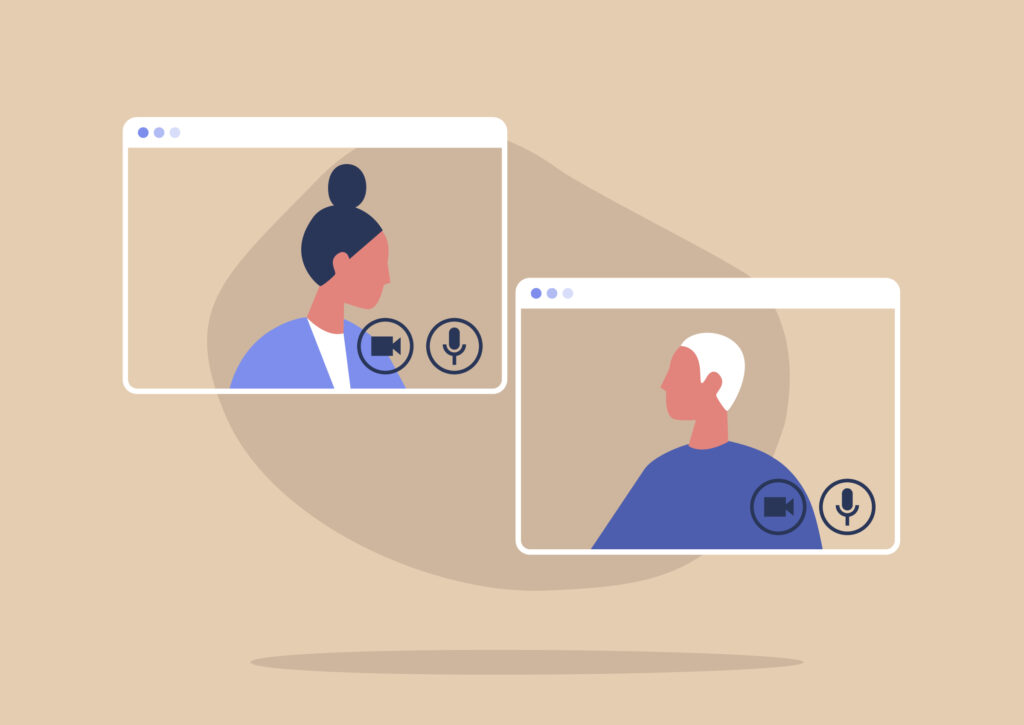
Ceaselessly conceptualised as one of the crucial frequent nervousness problems, Social Nervousness Dysfunction (SAD) is estimated – by an admittedly outdated examine – to have a lifetime prevalence of round 12% of the inhabitants (Kessler et al., 2005). SAD is characterised by extreme worry regarding how one acts, and could also be perceived, in social conditions.
Clark and Wells’ (1995) influential mannequin understands the dysfunction to be perpetuated by self-focused consideration and detrimental self-image. Cognitive Remedy for SAD (CT-SAD), the standardised NHS frontline remedy, combines this mannequin alongside the rules of Cognitive Behavioural Remedy, aiming to enhance signs by difficult detrimental self-perceptions. The 14-week remedy emphasises behavioural experiments. One such experiment centres round video suggestions, the place sufferers are inspired to problem their detrimental beliefs while viewing a video of themselves in a social encounter.
As healthcare begins to shift in the direction of digitisation, an internet-based, distant model of CT-SAD (iCT-SAD) has been developed. Requiring notably much less therapist steering and time, this enables professionals to tackle extra sufferers. Nevertheless, this begs the query: in pursuit of environment friendly therapies, can we threat ignoring the worth of in-person therapist interactions? And the way do behavioural experiments like video suggestions translate to distant codecs?
Wild, Warnock-Parkes, Stott and colleagues (2023) set forth to reply this query by investigating beforehand unanalysed video suggestions knowledge from two latest research investigating iCT-SAD.

Throughout video suggestions in iCT-SAD, sufferers obtain digital prompts to encourage reflection.
Strategies
Research 1 in contrast the results of CT-SAD and iCT-SAD in a UK pattern of 102 adults referred by NHS companies for SAD remedy (Clark et al., 2022). Sufferers had been assigned to both CT-SAD or iCT-SAD circumstances and accomplished a 14-week course of remedy.
Research 2 replicated the remedy and measures of Clark and associates’ examine, save the removing of the CT-SAD situation (Thew et al., 2022). Sufferers had been 44 self-referred Hong Kong-based adults who met standards for SAD and demonstrated ample understanding of English.
Video suggestions occurred through the third week. Sufferers recorded, then considered a video of themselves in a social interplay. In CT-SAD, reflection was guided by a therapist, whereas in iCT-SAD reflection was guided by digital prompts, with alternative to textual content a therapist afterwards. Sufferers had been required to finish questionnaires earlier than and after intervention, score self-perception statements (pertaining to nervousness, prevalence of feared beliefs and general efficiency) on scales from 1-100, and a self-report SAD symptomology questionnaire (Leibowitz Social Nervousness Scale [LSAS]).
Outcomes
Wild and colleagues opted to analyse video suggestions knowledge for every examine independently, then compared. For sake of ease, I’ll current outcomes on this order.
Research 1 aimed to find out whether or not iCT-SAD could be as efficient as its face-to-face counterpart, CT-SAD. Apparently, evaluation of video suggestions knowledge confirmed the identical general pattern in sufferers taking part in every methodology of supply. The pattern was an general enchancment between pre- and post- intervention measures: important decreases in self-perception of hysteria, prevalence of feared beliefs, LSAS nervousness scores and enchancment in scores of general efficiency. Nevertheless, you will need to observe that when put next utilizing Linear Combined Impact Fashions, CT-SAD was related to a higher diploma of change in self-ratings, however not LSAS, when in comparison with iCT-SAD. Albeit, it’s essential to place this into context – while CT-SAD could also be extra efficient, the chances of these experiencing enchancment in each interventions are extremely promising. Certainly, 100% of sufferers throughout circumstances reported decreases in diploma to which feared beliefs transpired, 98% of CT-SAD and 88% of iCT-SAD sufferers reported will increase in self-rating of social efficiency, and 96% of CT-SAD and 92% of iCT-SAD sufferers reported decreases in self-ratings of notion of exterior nervousness.
Research 2 aimed to check whether or not the optimistic results of video suggestions inside iCT-SAD would replicate in a Hong Kong-based pattern. Certainly, the info supported the findings of Research 1, with important general enchancment following intervention in all measures – self-perception in addition to LSAS nervousness rating. In reality, upon nearer inspection of the info, it should be acknowledged that between 84-95% – a major majority of individuals – demonstrated enchancment in every measure.
Lastly, Linear Combined Impact Fashions had been used to check the diploma of change between the pre- and post-video suggestions outcomes between iCT-SAD teams in Research 1 and Research 2. Upon analyzing the extent of change, no important distinction between research was discovered for any measure. In brief, which means the outcomes of Research 2 precisely replicate the iCT-SAD knowledge from Research 1. This additional helps the proof indicating the efficacy of the iCT-SAD video suggestions in bettering SAD signs following intervention and provides a cross-cultural aspect to the proof base.

Video suggestions was constantly related to enchancment in self-perceptions of social nervousness.
Conclusions
- Total, outcomes counsel that the video suggestions intervention inside iCT-SAD could also be an efficient means to problem and reduce detrimental self-perceptions related to SAD and additional scale back social nervousness ranges. This impact was supported in UK and Hong Kong research.
- When investigating the results of video intervention inside iCT-SAD within the Hong Kong and UK-based research, outcomes had been discovered to not considerably differ in regard to the diploma of change of measures. Outcomes aren’t solely comparable, however replicated.
- Nevertheless, upon comparability, video suggestions inside CT-SAD was related to higher quantities of change in detrimental self-perceptions between pre- and post- intervention scores in comparison with iCT-SAD. This impact didn’t lengthen to LSAS scores.

This analysis means that video-feedback could also be an efficient approach utilized in remedy for social nervousness to lower detrimental self-image and ranges of hysteria.
Strengths and limitations
The researchers acknowledged a notably restricted lack of management over timing of measures. The place self-report knowledge was collected straight earlier than and after suggestions, LSAS nervousness scores had been collected weekly. Moreover, sufferers in iCT-SAD had been capable of proceed with further modules straight following suggestions, so could also be additional alongside the course of remedy. Sadly, which means results should be interpreted with warning as adjustments could not essentially be related strictly with the intervention. The authors had been unable to regulate for the quantity of therapist steering offered – in each CT-SAD and iCT-SAD circumstances, which can affect the findings of this examine.
This writer attracts consideration to additional limitations:
- Results of video suggestions had been measured solely within the short-term, inside the week it was carried out. Therefore, questions should be raised concerning longevity of optimistic results related to the video intervention.
- Conclusions are over-reliant on self-report knowledge. While it could be essentially the most environment friendly manner of understanding self-perceptions, self-reports inherently depend upon introspection and interpretation that could also be unreliable.
- The participant swimming pools of every examine had been comparatively small and restricted to English audio system. Additional analysis is required to higher perceive the generalisability of findings.
- There’s a lack of know-how in regard to affected person retention, which can be important in regard to cross-cultural results, as UK sufferers had been referred by the NHS whereas Hong Kong sufferers had been self-referred they usually paid an upfront price for remedy.
Nevertheless, the strengths of this novel analysis ought to be acknowledged. The examine builds upon and provides to an current base of data, efficiently furthering our understanding of particular components inside SAD remedy. Additional, data is relevant in a medical setting since each variations of CT-SAD are presently in use, or being trialed inside the NHS. A multifaceted strategy allowed for a radical investigation of results, by analysing normal results, comparative results, and cross-cultural proof. Lastly, the usage of self-report questionnaires allowed for measures of self-perception, a focused end result. Additional, scores had been quantitative which allowed for statistical evaluation.

The usage of self-reported knowledge on this examine will be thought of each a power and a weak spot.
Implications
In an effort to contextualise Wild and associates’ findings, you will need to take a look at the each the precise and broader implications.
Firstly, particular. Upon trying on the general effectiveness in bettering instant post-video outcomes, outcomes appear to counsel that video suggestions will be efficiently carried out remotely. The replication of this impact in Hong Kong provides robustness to this conclusion. From a medical standpoint, that is promising proof that this particular tailored aspect of CT-SAD interprets effectively to a digitised format. Nevertheless right here it should be famous that CT-SAD was discovered to lead to a higher diploma of change in detrimental self-evaluations, seemingly indicating video suggestions carried out beneath direct therapist steering to be extra worthwhile.
At this level we should ‘zoom out’ to know broader implications. In brief, the examine does help the usage of digitised remedy for video suggestions, even when it isn’t fairly as efficient. Remotely delivered therapies could certainly characterize the way forward for remedy. We face a healthcare conundrum, with restricted psychological well being professionals accessible to help rising numbers of these in want. Remotely delivered, digitised remedy permits for wider distribution of remedy as therapists are required to take a position much less contact time, and as such can tackle extra sufferers. Accordingly, sufferers could entry remedy and get better sooner. Certainly as we stand, we face issues in SAD remedy. Alongside excessive prevalence, low treatment-seeking and low charges of pure restoration are additionally noticed (Waumans et al., 2022, Bruce et al., 2005). Is the shift to distant remedy one that may profit each affected person and therapist? Effectively… perhaps, and perhaps not. A digitised remedy could also be extra accessible – maybe particularly to these with social phobia – but, in looking for effectivity, we could lose sight of the worth of in-person therapeutic relationships.
Nevertheless, this query is already being investigated. As of Could 2023, NICE started evaluation, with iCT-SAD presently being trialed in an Oxford NHS Speaking Therapies service. This trial permits sufferers to opt-in to iCT-SAD and can measure outcomes over 7 months, together with satisfaction with remedy (see Clark, 2023). We are actually on the thrilling forefront of discovering the place remotely delivered CT-SAD suits inside our healthcare system. The current analysis contributed an vital understanding of video suggestions, and while not as efficient as face-to-face, the profitable adaptation and optimistic implications shouldn’t be ignored.
Now, to depart you with some meals for thought (or inspiration?). To construct upon the muse, this writer believes we want additional analysis into the longevity of video suggestions results, additional cross-cultural research, and at last an understanding of each affected person and therapist opinions of accessibility and effectiveness in remotely delivered remedy for SAD.

Precisely how worthwhile is the face-to-face steering that therapists present throughout a video suggestions session?
Assertion of pursuits
The writer has no conflicts of curiosity to declare.
King’s MSc in Psychological Well being Research
This weblog has been written by a scholar on the Psychological Well being Research MSc at King’s School London. A full listing of blogs by King’s MSc college students from will be discovered right here, and you may comply with the Psychological Well being Research MSc group on Twitter.
We often publish blogs written by particular person college students or teams of scholars finding out at universities that subscribe to the Nationwide Elf Service. Contact us in case you’d like to search out out extra about how this might work to your college.
Hyperlinks
Major paper
Wild, J., Warnock-Parkes, E., Stott, R., Kwok, A. P., Chan, M. H. L., Powell, C. L., … & Thew, G. R. (2023). Video suggestions to replace detrimental self-perceptions in social nervousness dysfunction: A comparability of internet-delivered vs face-to-face cognitive remedy codecs. Journal of Affective Issues, 331, 139-144.
Different references
Bruce, S. E., Yonkers, Ok. A., Otto, M. W., Eisen, J. L., Weisberg, R. B., Pagano, M., … & Keller, M. B. (2005). Affect of psychiatric comorbidity on restoration and recurrence in generalized nervousness dysfunction, social phobia, and panic dysfunction: a 12-year potential examine. American Journal of psychiatry, 162(6), 1179-1187.
Clark, D. M., Wild, J., Warnock-Parkes, E., Stott, R., Gray, N., Thew, G., & Ehlers, A. (2023). Greater than doubling the medical profit of every hour of therapist time: a randomised managed trial of web cognitive remedy for social nervousness dysfunction. Psychological Medication, 53(11), 5022-5032.
Clark, D. M., & Wells, A. (1995). A cognitive mannequin of social phobia.
Kessler, R. C., Berglund, P., Demler, O., Jin, R., Merikangas, Ok. R., & Walters, E. E. (2005). Lifetime prevalence and age-of-onset distributions of DSM-IV problems within the Nationwide Comorbidity Survey Replication. Archives of normal psychiatry, 62(6), 593-602.
Thew, G. R., Kwok, A. P., Chan, M. H. L., Powell, C. L., Wild, J., Leung, P. W., & Clark, D. M. (2022). Web-delivered cognitive remedy for social nervousness dysfunction in Hong Kong: A randomized managed trial. Web Interventions, 28, 100539.
Warnock-Parkes, E., Wild, J., Thew, G. R., Kerr, A., Gray, N., Stott, R., … & Clark, D. M. (2020). Treating social nervousness dysfunction remotely with cognitive remedy. The Cognitive Behaviour Therapist, 13, e30.
Waumans, R. C., Muntingh, A. D., Draisma, S., Huijbregts, Ok. M., van Balkom, A. J., & Batelaan, N. M. (2022). Limitations and facilitators for treatment-seeking in adults with a depressive or nervousness dysfunction in a Western-European well being care setting: a qualitative examine. BMC psychiatry, 22(1), 165.
Picture credit


